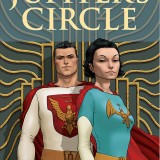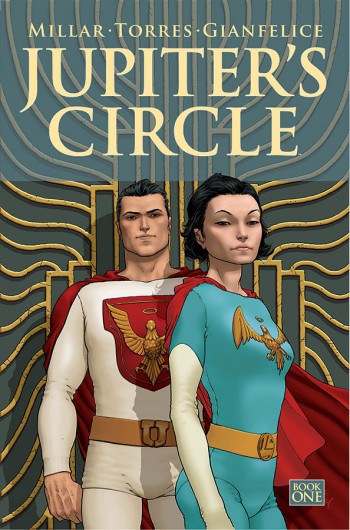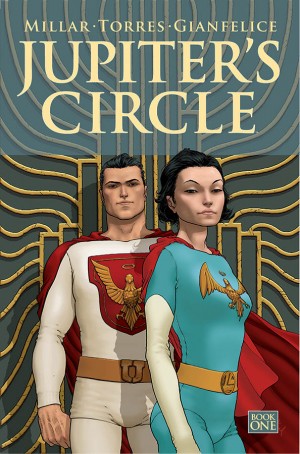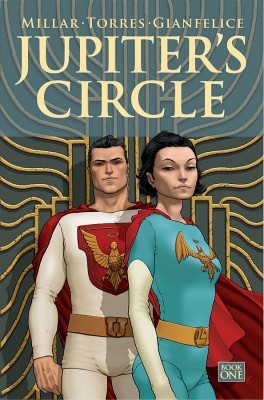
GRAPHIC NOVEL REVIEW: Jupiter’s Circle, Vol. 1
UNDERLYING THIS “PERFECTION” Since prequels are a thing in popular culture entertainment, Scottish comic writer Mark Millar obviously follows that prevailing zeitgeist by giving us readers the back stories of his positively received work Jupiter’s Legacy, JUPITER’S CIRCLE. Since his fellow Scottish partner and main artist extraordinaire Frank Quitely is anything but fast, he decides […]
UNDERLYING THIS “PERFECTION”
Since prequels are a thing in popular culture entertainment, Scottish comic writer Mark Millar obviously follows that prevailing zeitgeist by giving us readers the back stories of his positively received work Jupiter’s Legacy, JUPITER’S CIRCLE. Since his fellow Scottish partner and main artist extraordinaire Frank Quitely is anything but fast, he decides to focus more on crafting some interesting origin stories regarding the original superhero American team, The Union, in the background of the conservative decade of the 1950s, and the era of witch-hunting of suspected (or real) communists, socialists, and/or their sympathizers. The writer, and Frank Quitely’s chosen artist, Wilfredo Torres, narrate tales of personal demons some of the superheroes possessed while fulfilling their obligations to the American public in the first volume of the Jupiter’s Circle, recently released in trade paperback form by Image Comics.
Jupiter’s Circle, Vol. 1 comprises of issues #1-6, clocking 144 pages, and it has some additional art features such as Frank Quitely’s couple of cover arts and designs and stuffs related to Millarworld comics as only Mark Millar can pull-off. It divides into three distinctive standalone but interconnecting stories. The first two chapters focus on Blue-Bolt’s secret gender and his struggle and triumph against the harassment of Federal Bureau of Investigation (FBI) Chief J. Edgar Hoover. The next story focuses on The Flare’s extra-marital relationship with a nineteen-year-old girl, who has obsessed on anything superheroes. And the last one deals with Skyfox’s childishness as against to Brainwave’s maturity in the fight for the woman they both love. Three interesting and intriguing narratives in just the first part of the entire story…this is a great offer.
Mark Millar obviously patterns both his Jupiter’s Legacy and Jupiter’s Circle to DC’s Justice League (look at The Utopian, another Superman archetype; Lady Liberty to Wonder Woman; The Flare as to The Flash; Brainwave to Martian Manhunter; Skyfox is to Batman; and Blue Bolt as to Green Lantern) and references to anything Golden Age and Silver Age superhero comic book feel. Granted he accomplishes that one, but typical Millar as always, putting some uncomfortable and even so controversial elements to his superhero narrative. For examples, homosexuality is a great taboo in the 1950s, and Millar and Torres are totally unhinged in tackling that matter hands-on. The creative team even puts a shock value of having Hoover’s supposed sexuality in the printed pages. If that one is not a sure fire of brimstone historical scandal, I don’t know what other descriptions can go so. Unconventional in the sense Millar sprinkles some salacious, scandalous, and highly emotionally charged topics like infidelity, insecurity, manipulation, bullying, betrayal, and hatred to the main and even supporting characters to deconstruction the so-called “Golden Age” of American morality in justifying the frailties of being human despite members of the master class or superheroes. This scenario is perfectly executed in the second arc where The Flare flirts with a non-powered, 19-year-old lady while neglecting altogether his dutiful and faithful wife and children. After his divorce, his eldest son, whose powers manifests shortly, promises to get even with his old man sooner or later. That character cares almost nothing while having a grand time of his life with his courtesan while being under pressured and scrutinized by both The Union and the entertainment industry. More so, despite possessing superpowers, the human element of insecurity remains strong. This is evident to The Flare, Brainwave and Skyfox, especially in the last chapter of this volume, which also hints the end of the beginning of a very beautiful friendship between bests of friends and the planting of the seeds of discords that are both mentioned and referenced in the pages of Jupiter’s Legacy. Naturally, Millar knows precisely the utilization of pinpointing the trajectory point to the second volume and this serves him well that continuing readers and Millar fans can invest more to that future yet pivotal climatic arc in the few months.
Jupiter’s Circle also serves as filler to the overall grand narrative of Jupiter’s Legacy due to Quitely’s artistic methodological and painstaking artwork (read: Frank’s too slow). If that is the case then, this needs a suitable but worthy artist as well. Wilfredo Torres fills that job. He does issues #1 to #3 and #6, which the in-betweens are filled with temporary fill-in artist, Davide Gianfelice. Since the time is the 1950s, it is appropriate to give this prequel a sense of nostalgia, the feel of the “good-old-time” era. In that case, Torres executes the Darwyn Cooke-inspired artistic illustrations that are simple, clean, less detailed, a bit goofy, vibrant, minimalist, and colorful to gaze upon. This is neither a serious rip-off nor a swipe but the creative team’s overall tribute to the great Cooke himself. It is just Millar’s love of injecting some emotionally charged tropes that separates Cooke’s majestic superhero works from Jupiter’s Circle. Nevertheless, Torres’s illustrations capture that 1950s feel and hopefully, he draws the rest of the series.
The only drawbacks in this premier volume are the following. First, the art of Torres’s backup artist, Davide Gianfelice, is below par with the main illustrator. It is true that Davide follows the general artistic vision first and foremost, but upon comparison with the counterpart, the scratchy, a bit greasy and messy illustrations in some pages are very obvious to witness. If there is one consolation on that, it is the fact that Davide is a good team player. Lastly, as always, this volume tackles some rather disturbing or “mature” contents despite being inspired as a Golden Age/Silver Age work. Same-sex relationships, divorce, infidelity, and some fisticuffs violence are present here, to which Image Comics are something to admire with.
Jupiter’s Circle, Vol. 1 is a presentation of human frailties in the so-called Gold/Silver Age of comics and in the broader scope, the American conservatism and morale. Sure, there are definitely deviancies in every era or period and the creative team presents exactly what are those weaknesses that define the ugly side of humanity. Despite the typical cynicism and shock value Millar narrates, he still puts a dosage of positivity around, particularly the mantras “heroes-win-in-the-end” and “that starts well ends well” in the first two stories. Thus, this premier chapter is a mixture of the nostalgic years of superhero comics and Millar’s brand of controversial writing that reads well and make readers reflect that superheroes were and always be, like us — HUMANS.



















